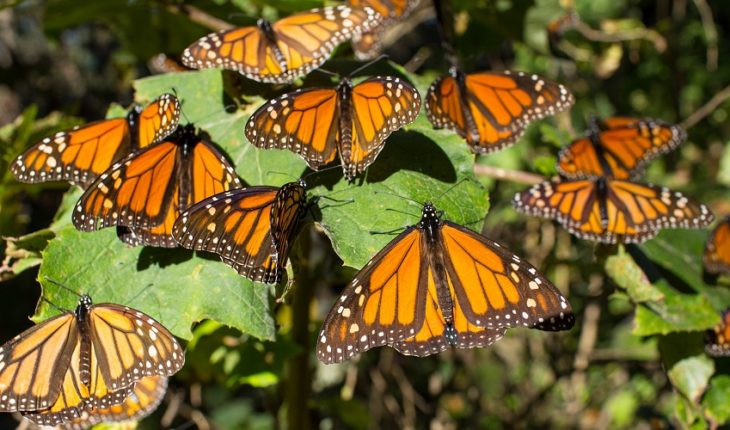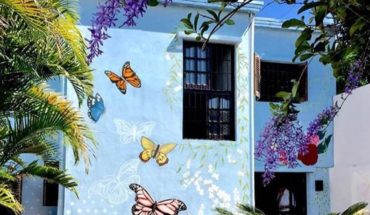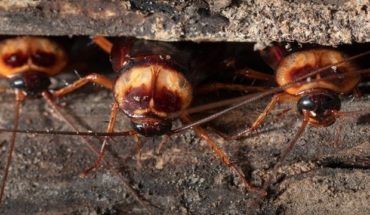“while the butterflies keep coming, we will have work”, says Javier Ambrocio while observing the sanctuary of the monarch butterfly Sierra Chincua. A cool breeze blows in the steep hillside, over 2,400 meters above the sea level.
Ambrosio works guide in the reserve of the biosphere of the monarch butterfly, which extends into the mountains between Michoacan and the State of Mexico. The time of hibernation, when millions of butterflies arrive at the reserve, began in mid-November and elongates until March.
North America achieves goal of conservation of the butterfly monarch the people who lives in the small village of Ambrosio, Cerro Prieto, Michoacán, depends on the monarch for seasonal work. However, complex environmental factors have lowered the population of monarch butterflies and there are no guarantees that Ambrosio and its neighbors will be able to work among the butterflies in the coming years.
Extreme weather, deforestation and the use of herbicides are reducing the population of butterflies in North America. Another challenge is local: Mexico’s largest mining company expects reoperation within the biosphere reserve, putting at risk the continuing efforts to conserve the habitat of butterflies.
If you look to the West from the Sierra Chincua Butterfly sanctuary, the deep green of the forest cover gives the way to agricultural land and greenhouses. From 2012, the illegal deforestation in the core area of the reserve has been almost eradicated, but continues in buffer zone, and protecting the reserve is not an easy task in Michoacan, a State where cartels often behind illegal logging.
“Those who come to cut down trees are people from outside the community,” said Ambrosio. “Here we respect the forest.”
In butterflies at Sierra Chincua sanctuary, there are handwritten signs that say: “Don’t make noise!”. The trees are dyed Orange up to 20 meters away, since the branches are full of butterflies. A sealed-off observation area keeps the tourists to a safe distance from trees wrapped in butterflies.
While their populations are in decline, the annual spectacle of the migration of the butterflies still captivates tourists. Tens of thousands of people visit Michoacan and the State of Mexico every year to enjoy the view. Monarch butterflies arrive in these forests fresh, populated by FIR (Abies religiosa), pine (Pinus spp.) and oak (Pinus and Quercus), in search of a safe habitat for the winter months.
The vaquita and 370 species at risk, with less budget for protection in 2019 butterflies Hibernate in 11 sanctuaries each year, according to Eduardo Rendón WWF biologist. The director of the program of butterflies is monarch of WWF, a collaboration with the Mexican company Telcel.
Three major threats being that the population of butterflies in North America down: deforestation and forest degradation in Mexico have dwarfed considerably the scope of the habitat of butterflies while that changes the use of the Earth and the increase in the use of the herbicide glyphosate have reduced the availability of milkweed in the us.
The Center for biological diversity has discovered that dicamba, a recently approved herbicide will also damage the population of monarch butterflies. Both herbicides are toxic to the milkweed, the only source of food for the caterpillars of the monarch butterfly. The last major threat is the extreme climate in Mexico and Northern habitats for butterflies. The sudden shock of cold, heavy rains and snow can affect Butterfly populations.
According to a study from 2002 by the expert in butterflies monarch Lincoln Brower, died recently, 44% of the forest habitat of quality in Mexico has been degraded by illegal logging between 1971 and 1999. In recent years, WWF and the Mexican environmental authorities have curbed the illegal logging in the core area of the reserve, but deforestation continues in buffer zone.
The National Commission of Areas natural protected of Mexico (Conanp) works with WWF-Telcel, besides with the State Governments of Michoacan and the State of Mexico, to protect the butterflies and their habitat. Rendon said that to ensure work success, Butterfly Conservation and local development must go hand in hand. He added that you programs such as those in training for the community so that they produce and sell local varieties of mushrooms guarantee that reserve residents do not have to rely on deforestation by economic desperation.
You can interest: at risk, half of the national population of Jaguars if train Maya does not meet environmental law “are trying to create a comprehensive project that not only focuses on the conservation of the monarch itself, but save the entire ecosystem” , says Rendon.
Conservationists had not always a friendly approach in work with local communities, who are descendants of indigenous Otomi and Mazahua. Not long ago, the logging and mining were the economic engines of the mountainous region between the State of Mexico and Michoacan. As both industries were reducing, the local communities were against the restrictions of living within the ecological reserve.
Unlike the parks of federal property in the us, most of the reserve is in the hands of local communities known as ejidos. The ejido was the vehicle of the great agrarian reform of Mexico in the mid-20th century. The large estates were divided and the people who worked in the haciendas could access to ask land of the ejidos.
In the ‘ 70s, the researchers Fred Urquhart and Ken and Cathy Brugger were among Americans and Canadians who wanted to find out where monarch butterflies Hibernate. In 1975, the Bruggers discovered the colony Cerro Pelon in Michoacan. Although local communities had seen butterflies, that was the first time that showed that monarch butterflies travel from United States and Canada to spend the winter in the forests of Michoacan and the State of Mexico. Work to protect the area began after the discovery.
The area was named “Reserve and wildlife refuge” in 1980, and in 1986 it became a federally protected area. The reserve of the biosphere of the monarch butterfly (RBMM) was founded in 2000 and more than 56 000 hectares. Its core area was appointed UNESCO World Heritage site in 2008.
This research was published initially in Mongabay Latam and is taken up with the authorization of the author and medium. To continue reading and query complete da click here thanks for reading! Help us to continue with our work. How? You can now subscribe to political Animal on Facebook. With your monthly donation, you will receive special content. Find out how to subscribe here. Check our list of frequently asked questions here.
translated from Spanish: Deforestation and mining threaten the monarch butterfly
February 2, 2019 |





